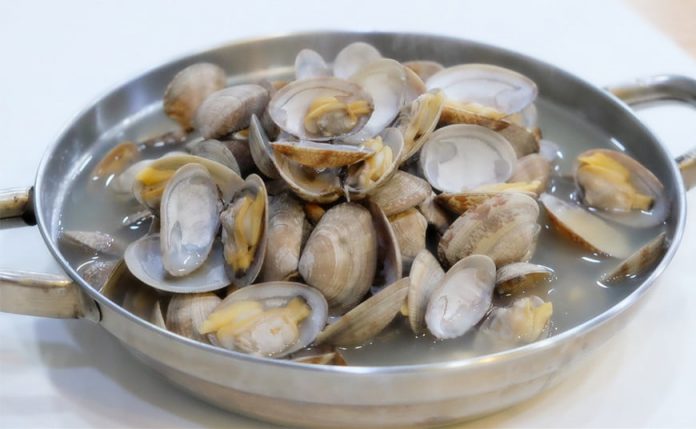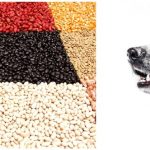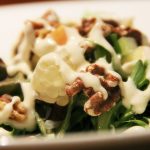Most dogs delight in eating fish, mainly because it is easier to chew compared to meat. But how about other types of seafood, like shellfish? Can dogs have them without experiencing any digestive problems?
In today’s post, we put one kind of seafood on the spotlight: clams – are they safe for canines? If so, then how should you store and prepare them for your puppy’s consumption? We will dissect clams, their health benefits, as well as their possible effect to your pet.
Can Dogs Eat Clams?
Yes, on one condition. The clams should be out of the shell before serving them to your pet, otherwise the shells are likely to hurt your Peanut’s intestinal tract.
In adult dogs, small shells will likely end up in the intestine and in the stool, so you don’t have to panic. The shells of clams are not poisonous. In fact, they contain calcium that can help puppy one way or another.
The real problem here is when a pup ingests big shells. The risks depend on the size of the ingested shells and the size of your dog. If the shell was ingested whole, it can cause blockage in the dog’s digestive tract.
The worst thing to happen the shell having sharp edges as these could cause irritation and ulcers. This is the reason why you should not induce vomiting. Forcing those sharp edges back up can do more harm than good.
What To Do If Your Dog Ate Clam Shells
Your dog may start vomiting after ingesting a foreign object like seashells. Your dog may also suffer from a bad case of diarrhea after gobbling down the shells of clams. If his diarrhea is not getting any better and you can already spot some blood in his stool, it is best to take him to a vet.
On the occasion that you cannot immediately take your dog to a veterinarian, soothe his stomach by offering foods rich in fiber. This could be pureed pumpkin, whole bread, or oatmeal. Keeping him hydrated would also help.
The fiber and the water allow the stool to easily pass through his system. It also improves his chances of having the shell fragments pass through his bowel. Observe your pet’s bowel movements and massage his abdomen at least twice a day to check if there is any pain. Aside from diarrhea and vomiting, dogs may experience lethargy or lack of energy and enthusiasm.
There are a few over-the-counter medications you can give to a dog that ingested clam shells. One of them is Pepcid, a histamine-2 blocker commonly used in reducing acid in the stomach. The other one is Tagamet which works by blocking acid secretion in the stomach to give it a more favorable acidity level. Zantac is also a histamine-2 blocker that decreases stomach acid production.
While these meds do not require prescription, it is well advised to give them to your pet after getting a doctor’s approval. It is best to get your vet’s green light when you have doubts in giving OTC drugs to your dog.
Furthermore, it is important to keep those shells out of your dog’s reach. Almost all of our furry friends have the habit of swallowing all kinds of things. Keep a separate bin for those shells just in case your pet likes raiding your trash.
Dogs Eating Clams: What Are the Risks Involved?
Clams are filter feeders, meaning they have no biting mouthparts so they eat through their siphons. This also means they can absorb noxious substances from poisonous microalgae. There are certain elements influencing the toxicity levels in clams, one of those elements being the season during which they have been caught.
There was a belief that you should not eat clams on months not containing the letter R. In simpler terms, the old saying emphasizes that you should avoid shellfish during summer months, from May until August. But what is the scientific explanation behind the “R” rule in eating shellfish?
Actually, the rule only applies on oysters. This is due to the fact that the Red Tide usually occurs during the summer months. Because of this, experts tend to have stricter monitoring rules during these months in order to make sure the consumers only get decent seafood that is free from toxins.
What happens if your dog ate shellfish that absorbed high concentrations of algae? He may suffer from paralytic shellfish poisoning (PSP), a condition that can kill humans and animals. The poisonous microalgae causing PSP are believed to be 1,000 times more deadly than cyanide. If the dog is lucky enough to survive, he will be given antibiotics until he is completely fine.
As the name suggests, the bio-toxin causing PSP can paralyze muscles and can also affect the nervous system. Unfortunately, there is no way to remove the bio-toxin from clams. A contaminated clam will remain contaminated even after freezing or cooking.
The poison can take effect in just minutes, but in some cases it will take one to two hours to see any symptoms. PSP is often characterized by difficulty in breathing, tingling toes, and lack of control of the arms and legs.
In case you haven’t heard, there are already cases of dogs that passed away due to this naturally occurring disease. In January 2018, two dogs died after ingesting contaminated seafood washed up on the coasts of Norfolk and Suffolk. According to the current European Union regulations, live bivalve mollusks (the group clams belong in) should not have toxin levels of more than 800 micrograms per kilo.
The thing is that contaminated shells taste the same as the safe ones so it’s hard to determine toxicity just by looking at them or tasting them. While you really can’t figure out the toxin levels by yourself, the best thing you can do is to never allow your pet eat any seafood from the shore. It pays to keep a close eye on your pet when you are walking on the beach. As the adage goes, it is better to be safe than sorry.
How to Choose Clams for Your Pet?
Just like you, your dog is also entitled to fresh seafood. Besides, giving your dog fresh food assures he will not suffer from any kind of health problem, especially paralytic shellfish poisoning. When buying clams, here are some indications to help you determine that what you are buying is fresh and still good for cooking:
- Look for closed shells when buying hard-shell clams. This indicates that they are still alive and are still ideal for cooking.
- Your clams should have a briny and natural smell. If they don’t smell like the sea, the chances are they are no longer fresh.
- Discard broken shells. Whether you are buying soft-shell clams or hard-shell clams, they should not be wide-open or broken. A clam’s shell should remain closed until you cook them. They are supposed to pop open on their own once they are completely cooked.
- For soft-shell clams, you should be able to slightly pull off the siphon. More commonly known as steamers, these clams have larger siphons because they can be found deeper in the sand. This explains why soft-shell clams cannot be closed entirely.
- When buying canned clams, always check the label. Fresh clams are always a better option but if you cannot buy decent chopped clams at the supermarket, you can also go for canned clams.
What Are the Benefits of Clams For Dogs?
There may be potential dangers involved in giving clams to dogs. But on a positive note, clams can be a wholesome treat for dogs when they are given in the proper way. Here are some of the health benefits of clams for your pet:
- They are an excellent source of iron – Did you know that clams have more iron content than steak and beef liver? You will get as much as 24 mg of iron for every 3 ounces of this seafood. This can be a good addition to the diet of iron-deficient canines. Iron deficiency in canines can result in anemia, a condition that appears when the red blood cells do not develop as they should.
- They can regulate blood sugar levels – Clams have manganese, a trace mineral that is known to regulate the blood sugar level. Just like their owners, canines are also prone to diabetes. The worst part is that Diabetes Mellitus in dogs cannot be cured. Once a dog has been diagnosed with diabetes, he will need to undergo a life-long treatment. As a pet parent, you can help your dog prevent diabetes by offering healthy food choices. You may add seafood to his diet to give him balanced meals.
- Clams can prevent the cognitive dysfunction syndrome. This condition is the equivalent of Alzheimer’s disease in canines. Like Alzheimer in humans, senior dogs can also have declined cognitive function. Statistics revealed that the symptoms of this disease are present in more than 60% of dogs aged 15-16, and around 28% of dogs aged 11 and 12 currently have it.
- Clams can aid in weight loss among pups – clams contain around 25% of riboflavin also known as vitamin B2. This water-soluble vitamin is essential for growing dogs. Without enough riboflavin, a pup’s growth may be impaired which can lead to more serious health issues, such as collapse, anorexia, and ataxia or lack of muscle control.
How to Properly Prepare Clams?
Keep these things in mind to get rid of all the sand and salt from your clams:
- Store the clams in a cool area as soon as you got home. This allows the clams to breathe. You may also cover them with a wet towel before placing them in the fridge in order to help keep the clams moist.
- Soak them in fresh water before cooking. Immersing the clams in water for around 20 minutes allows them to push the salt water and sand out of the shells.
- Clean the clams using a firm brush. To make sure there is no more sand or any other type of barnacles left, better scrub it off with a brush.
What Are The Ways to Cook Clams For Pets?
1.Stuff the clams with organic vegetables. What’s nice about this baked dish is that every vegetable is purely organic. Right from the bell peppers down to the parsley, this dish uses high-quality veggies. It also has chopped bread that will make your pooch instantly crave for more.
2.Mix them with liver to create a homemade dog food. Pet parent Tanya Wilhelm shared her healthy dog food recipe using clams and organic beef liver as the main ingredients. She added organic carrots, hulled barley, blueberry juice, and dog probiotics. Let your pet doctor know if this is the first time you are adding dog probiotics to your dog’s diet. If your dog is lactose intolerant, consider non-dairy probiotics.
3.Combine the clams with strawberries. Another recipe shared by Tanya, this healthy dog food is bursting with flavors. The strawberry and blueberry juice make it sweet while the shitake mushroom gives it a slightly earthy and smoky taste. The pork kidney makes it tasty while the clams make the dog food a little extra savory. This recipe is made more nutritious with the added organic celery, dog probiotics, and brown rice. When using mushrooms, make sure they are store-bought. When you are not sure where the mushrooms came from, better not use them because they could be toxic to your pet.
Do note that these clam recipes for dogs were created with the guidance of a holistic veterinarian. While they use healthy and canine-friendly ingredients, you should consider the fact that different pets have different food tolerance.
If you are interested to try the recipes mentioned above, it is best to consult your vet first. This is very important, especially if your pet is not really used to eating clams.
Conclusion
Clams are a healthy treat for dogs as long as they are fully cooked and out of their shells. They should be given to pets in moderation because feeding dogs too much seafood may cause them harm. If your dog shows an unusual behavior or symptoms after eating clams, it is best to stop giving them to him.






















